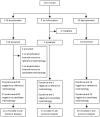Validation of a Methodology for the Detection of Severe Acute Respiratory Syndrome Coronavirus 2 in Saliva by Real-Time Reverse Transcriptase-PCR
- PMID: 34926372
- PMCID: PMC8674452
- DOI: 10.3389/fpubh.2021.743300
Validation of a Methodology for the Detection of Severe Acute Respiratory Syndrome Coronavirus 2 in Saliva by Real-Time Reverse Transcriptase-PCR
Abstract
In January 2021, the Chilean city of Concepción experienced a second wave of coronavirus 2019 (COVID-19) while in early April 2021, the entire country faced the same situation. This outbreak generated the need to modify and validate a method for detecting severe acute respiratory syndrome coronavirus 2 (SARS-CoV-2) in saliva, thereby expanding the capacity and versatility of testing for COVID-19. This study was conducted in February 2021 in the Chilean city of Concepción during which time, the town was under total quarantine. The study participants were mostly symptomatic (87.4%), not hospitalized, and attended care centers because of their health status rather than being asked by the researchers. People coming to the health center in Concepción to be tested for COVID-19 (via reverse transcriptase polymerase chain reaction [RT-PCR]) from a specimen of nasopharyngeal swab (NPS) were then invited to participate in this study. A total of 131 participants agreed to sign an informed consent and to provide saliva and NPS specimens to validate a method in terms of sensitivity, specificity, and statistical analysis of the cycle threshold (Ct) values from the RT-PCR. Calculations pertaining to the 127 participants who were ultimately included in the analysis showed sensitivity and specificity at 94.34% (95% CI: 84.34-98.82%) and 98.65% (95% CI: 92.70-99.97%), respectively. The saliva specimen showed a performance comparable to NPS as demonstrated by the diagnostic parameters. This RT-PCR method from the saliva specimen is a highly sensitive and specific alternative compared to the reference methodology, which uses the NPS specimen. This modified and validated method is intended for use in the in vitro diagnosis of SARS-CoV-2, which provides health authorities in Chile and local laboratories with a real testing alternative to RT-PCR from NPS.
Keywords: RT-PCR; SARS-CoV-2; detection; saliva; validation.
Copyright © 2021 Escobar, Díaz, Díaz-Dinamarca, Puentes, Alarcón, Alarcón, Rodríguez, Manzo, Soto, Lamperti, Díaz, García-Escorza and Vasquez.
Conflict of interest statement
The authors declare that the research was conducted in the absence of any commercial or financial relationships that could be construed as a potential conflict of interest.
Figures



Similar articles
-
Diagnostic Performance of Self-Collected Saliva Versus Nasopharyngeal Swab for the Molecular Detection of SARS-CoV-2 in the Clinical Setting.Microbiol Spectr. 2021 Dec 22;9(3):e0046821. doi: 10.1128/Spectrum.00468-21. Epub 2021 Nov 3. Microbiol Spectr. 2021. PMID: 34730436 Free PMC article.
-
Diagnostic Performance Assessment of Saliva RT-PCR and Nasopharyngeal Antigen for the Detection of SARS-CoV-2 in Peru.Microbiol Spectr. 2022 Aug 31;10(4):e0086122. doi: 10.1128/spectrum.00861-22. Epub 2022 Jul 18. Microbiol Spectr. 2022. PMID: 35867471 Free PMC article.
-
Diagnostic Performance and Tolerability of Saliva and Nasopharyngeal Swab Specimens in the Detection of SARS-CoV-2 by RT-PCR.Microbiol Spectr. 2023 Jun 15;11(3):e0532422. doi: 10.1128/spectrum.05324-22. Epub 2023 Apr 24. Microbiol Spectr. 2023. PMID: 37093085 Free PMC article.
-
Alternative clinical specimens for the detection of SARS-CoV-2: A rapid review.Rev Med Virol. 2021 Jul;31(4):e2185. doi: 10.1002/rmv.2185. Epub 2020 Oct 22. Rev Med Virol. 2021. PMID: 33091200 Review.
-
SARS-CoV-2 saliva testing using RT-PCR: a systematic review.Int J Infect Dis. 2022 Aug;121:166-171. doi: 10.1016/j.ijid.2022.05.008. Epub 2022 May 13. Int J Infect Dis. 2022. PMID: 35577250 Free PMC article.
Cited by
-
Performance of nasopharyngeal swab and saliva in detecting Delta and Omicron SARS-CoV-2 variants.J Med Virol. 2022 Oct;94(10):4704-4711. doi: 10.1002/jmv.27898. Epub 2022 Jun 8. J Med Virol. 2022. PMID: 35642439 Free PMC article.
-
Saliva-based methods for SARS-CoV-2 testing in low- and middle-income countries.Bull World Health Organ. 2022 Dec 1;100(12):808-814. doi: 10.2471/BLT.22.288526. Epub 2022 Oct 3. Bull World Health Organ. 2022. PMID: 36466209 Free PMC article.
-
The effect of sample site and collection procedure on identification of SARS-CoV-2 infection.Cochrane Database Syst Rev. 2024 Dec 16;12(12):CD014780. doi: 10.1002/14651858.CD014780. Cochrane Database Syst Rev. 2024. PMID: 39679851 Free PMC article.
-
The Diagnostic Performance of Various Clinical Specimens for the Detection of COVID-19: A Meta-Analysis of RT-PCR Studies.Diagnostics (Basel). 2023 Sep 26;13(19):3057. doi: 10.3390/diagnostics13193057. Diagnostics (Basel). 2023. PMID: 37835801 Free PMC article. Review.
References
-
- World Health Organization. Clinical Care Severe Acute Respiratory Infection: toolkit. COVID Adaptation. Geneva (2020). Available online at: https://www.who.int/publications-detail/clinical-care-of-severe-acute-re...
-
- Ministerio de Ciencia y Tecnología . Positividad diaria media COVID-19. (2021). Available online at: https://github.com/MinCiencia/Datos-COVID19/blob/master/output/producto4...
-
- Ministerio de Ciencia y Tecnología . Datos de vacunación COVID-19. (2021). Available online at: https://github.com/MinCiencia/Datos-COVID19/blob/master/output/producto7...
Publication types
MeSH terms
LinkOut - more resources
Full Text Sources
Medical
Miscellaneous

